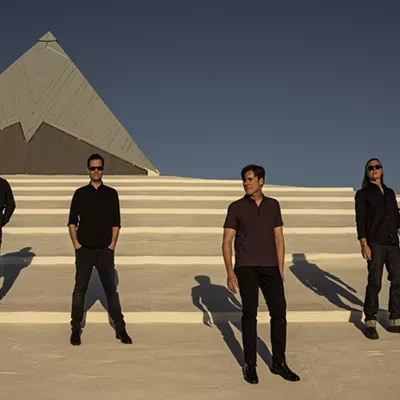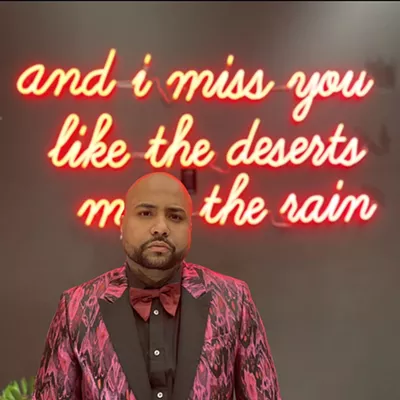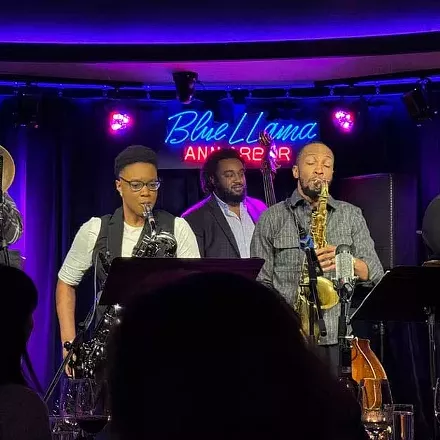The strangely amusing, quasi-operatic presentation that Dave Longstreth, aka the principal Dirty Projector, has created over the course of the last several years (with the aid of roughly 25 musicians) is entitled The Getty Address; four score and seven hours ago, I attempted to make sense of it.
Described as a "sprawling, layered glitch opera" (note: from context, a "glitch opera" seems to be a sort of fucked-up mishmash of chamber music, techno, chorale and free-verse collages comprising the lyrics of Don Henley mixed with Longstreth's own ruminations from previous albums), The Getty Address has an aesthetic that the casual listener may find difficult to suss out. Fortunately, there's a narrative--only it doesn't make any sense! Try this on: "The Getty Address is about the conflict of Hernan Cortes and the Aztecs in 1519-21, the virtualization of wilderness on a completely circumscribed globe, dirty projection, and love cerebral and spiritual." Mr. T might have a word or two about "jibba jabba" if confronted with such a description.
Not that we should use Mr. T as our aesthetic guide, at least not all the time. But when a record by someone who dropped out of Yale only to repair to Olympia, Wash., purports to be "inspired by Aztec mythology, the Eagles, and the 9/11 aftermath," art school bullshit detectors installed by NORAD (in an attempt to defend against the pernicious art school communism of the '50s) sound klaxons to the high hills, and the Department of Homeland Security raises the alert level to Burnt Sienna: high incidence of crap imminent.
It's surprising, then, that The Getty Address, under-sensical yarn that it is, manages moments of dramatic and musical tension that echo both Prokofiev and Björk. Longstreth's voice evokes Jeff Buckley at times, as he waxes in a profound ("Maybe the truth in searching / is not having found") and nonsensical ("So bleed sarcophagi / romantically / replete with dignifying reconstructive makeup") fashion. All the while, The Getty Address clings to the central narrative conceit--the story of Don Henley's journey, abetted by Sacagawea (aka The Eagles' "Witchy Woman"), through the harsh landscape as "unwitting colonist and the virgin uncolonized ..." to a lake of oil in Pennsylvania, and the ultimate destination, a gift shop ... . A lot of thought went into The Getty Address, but it's difficult to determine if this is an effort misplaced.
Longstreth's deconstructionist methodology in creating The Getty Address involved taking recordings of wind, cello and choral arrangements that he commissioned and manipulating them into a sonic collage with electronic beats, over which he and the character of Sacagawea (voiced by Lucy Greene) sing, and the effect is at times roughly similar to some of the work of contemporaries like M83 or the more hip-hop minded Prefuse 73.
Longstreth must be taking the piss with narrative explication such as "his mental choir suggests the word 'Kangarwomb,' because Henley's place is like the external womb of a kangaroo," but there are hints of an academic, arty stock-seriousness that detract from the overall effectiveness of the "work" (case in point being that The Getty Address is something that almost necessitates the use of words like "work" to describe it; is there a more pretentious way to describe a recorded work that's supposedly part of the popular idiom?). As he puts it in extensive notes about his arrangements, he's riffing on "several different kinds of twentieth-century exoticism," ("Not Having Found") and wants the listener to be aware that he's referencing "primitivist Stravinskian rhythmic punctuations in the low register play(ing) against the steady eighth note Minimalist pulse of the choir ... ." Uh-oh, the DHS just raised the alert level again, this time to Saffron: dangerous liquid waste is showering upon you--get out of the way!
One must admire the endeavor of the Dirty Projectors tour, however. Longstreth has assembled a portable orchestra, a cadre of "Finnish goth divas," and the performance of The Getty Address will be accompanied by James Sumner's animated film of the story. The commercial potential for such an undertaking is necessarily limited (the Dirty Projectors will only be performing in art spaces like Solar Culture) and is quite clearly art for art's sake. Whether that's good or bad remains to be seen (and heard).













